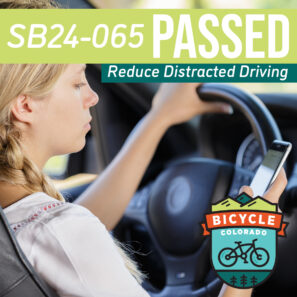What to do in the case of a crash
We all hope we won’t get into a crash. Until and unless the safety status quo on our streets changes, there is a chance that some of us will be hit and injured. With the wish that this never happens to you, we wanted to provide important advice for what to do if you or a loved one is in a crash while riding their bike. This blog covers insurance and how to stay legally protected following a crash.
Before a crash
Get insured
We acknowledge that securing and maintaining health insurance is often prohibitively expensive, but if it’s something you can fit in your budget, it will be worth it in the case of extreme medical bills.
Bike lawyers recommend that in addition to health insurance, people riding bikes—whether for commuting, road biking or anything else—should also have auto insurance with medical payment coverage and uninsured and underinsured motorist coverage. If you don’t own a motor vehicle, you can get non-owner car insurance. This can help get you compensation for medical bills whether or not the driver is insured and without delays from the at-fault party’s insurer.
Be aware
As bicyclists are considered “vehicles” under Colorado law, we encourage you to follow road rules where it is safe and reasonable for you to do so.
Data from the Colorado Department of Transportation (CDOT) covering 2017-2019 indicates that 72.2% of reported crashes between bicyclists and drivers took place at intersections or were “intersection related” in that time frame.
The new Colorado Safety Stop helps keep people riding bikes safer at intersections because it provides a legal option to clear the intersection before other traffic arrives. Thanks to the Colorado Safety Stop, you are legally permitted to:
- Yield at stop signs, provided there is no other traffic with the right of way at the intersection, including pedestrians; you are riding at or below 15 miles per hour; you are 15 or older
- Stop and then go straight or make a right turn against the red light at stop lights, provided there is no other traffic with the right of way immediately approaching the intersection; you yield to traffic with the right of way including pedestrians; and you do not attempt this maneuver at left turns except onto a one-way street.
On the scene of a crash
If you were hit
- Do not remove your helmet or allow your helmet to be removed until you have been examined by a medical professional. Helmet removal can exacerbate potential head, neck and spinal injuries.
- Do not move unless you are in immediate danger, and accept the help of others to move out of the roadway safely. You may not know the extent of your injuries due to adrenaline and shock.
- Call 911 to report the crash and that you are injured.
- Take photographs (or ask another person to take photos) of yourself, your bike and other equipment and the scene and document your injuries.
- If you are able to, get the driver’s information: full name, driver’s license information, insurance information, address. DO NOT otherwise interact with the driver.
- Get the information of the investigating police officer (i.e. name, phone number). A business card is ideal.
- Get the full names and contact information of all witnesses.
- Accept medical care.
If you were a witness
- Call 911 to report a crash and injury.
- Be present to reassure the bicyclist and tell them medical care is coming.
- DO NOT move an injured or unconscious bicyclist unless they are in immediate danger on the roadway. DO NOT remove their helmet. If they are conscious and able to move and need to move, have them sit or lie down outside of the roadway and wait.
- Take photos and videos of the scene, the bicyclist, the driver, the vehicle, etc. before anything is moved.
- Ensure the police have the bicyclist’s name and contact information and provide your own statement.
Post crash
If you were hit
- Do not clean, throw away or get rid of what you were wearing, your helmet or your bike after the crash.
- Ensure the police accurately take your statement.
- Continue to document your injuries, missed days of work or activities, how you are feeling, how this crash has hurt or inconvenienced you, receipts for medical care, devices or prescriptions, etc.
- Contact an attorney. This step is vitally important. Bicycle Colorado can help connect you—and the first consultation is always free.
- Decide whether you will work with an attorney or handle claims against the at-fault driver and insurer yourself.
- Seek and secure emotional and mental health support during this traumatic time.
For family in the case of serious injury
- Keep everything your loved one was wearing, including their bike and helmet, and do not clean any of them or repair them.
- Connect with an attorney as soon as possible who can help pursue a claim against the at-fault driver and the insurer and guide you through the process. Bicycle Colorado can help connect you—and the first consultation is always free.
- Document all medical bills, other costs, how you are feeling as loved ones, financial impacts and anything else that has occurred as a result of your loved one’s injury.
- Seek and secure emotional and mental health support during this traumatic time.
Remember that an initial consultation with an attorney does not mean you are retaining them for counsel. They will help you decide whether the case needs their support or if you can pursue the case yourself.
Many thanks to Brad Tucker of Colorado Bike Law for his insight and input. Brad is the Board President of Bicycle Colorado and we are grateful for his work on the board and his support of the organization. Thanks as well to Brian Weiss and Megan Hottman.
Leave A COMMENT
Our twitter feed is unavailable right now.









COMMENTS (4)
Patty Gaspar -
Can we re-publish your article in the Denver Bicycle Touring Club’s monthly newsletter?
Aishwarya Krishnamoorthy -
Thanks for asking, Patty! Absolutely, you can re-publish. If you are able to link back to this site, we would appreciate it!
Ashley -
Please begin a public awareness campaign. I appreciate this information. Corrado has changed dramatically in the last 3 years. Since the population boom in Colorado with so many people from Texas, cities where they literally don’t have sidewalks and no pedestrians are allowed, these drivers are oblivious, entirely unaware. Please put PSA on the radio more often, every channel. Please do local YouTube and FB and Google Ads and announce this drivers safety course on every highway billboard. I’m done with being almost run over by people with Texas license plates.
Mari Meier -
Thanks for sharing your experience. A lack of consistent drivers’ education is a problem everywhere.